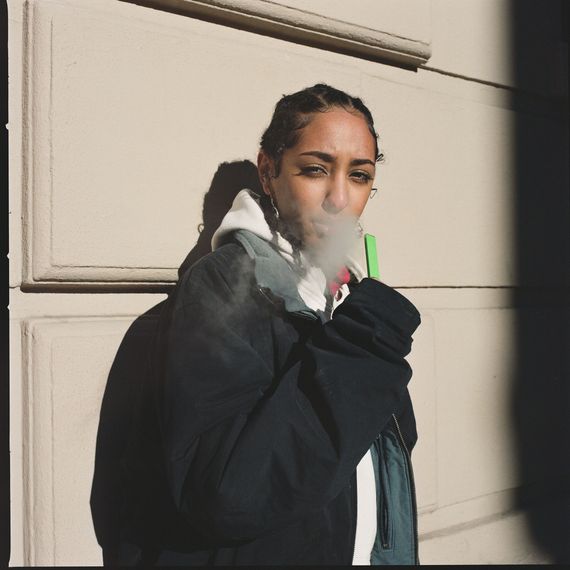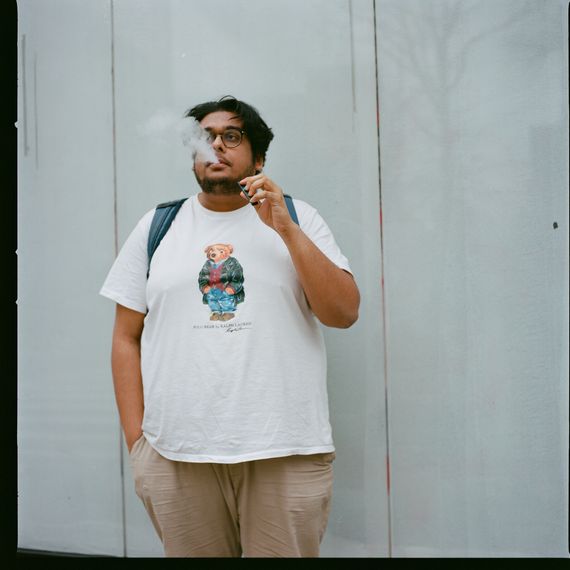
This article was featured in One Great Story, New York’s reading recommendation newsletter. Sign up here to get it nightly.
Dr. Lynn D’Andrea was standing in a small consultation room on one of the upper floors of the Children’s Wisconsin hospital this past Fourth of July weekend when a younger colleague on the pulmonary team, Dr. Brian J. Carroll, told her she needed to see a teenager who was having severe difficulty breathing. As Carroll later explained, young doctors are trained to deliver a quick, single-sentence synopsis — a “one-liner” — to the attending physicians in the hospital when preparing them for a new consultation. The one-liner in this case began, “Previously healthy teenager coming in with two to three weeks of fever, weight loss, bilateral chest X-ray findings.”
D’Andrea, who had been on call at the hospital that entire week and holiday weekend, at first believed Carroll had misspoken. “I thought we were mixed up,” she admitted, “and he was telling me the same consult for a second time.”
“No, Dr. D’Andrea,” Carroll replied. “There are three of them.”
Beginning the previous Monday, July 1, three adolescents had shown up at the hospital with eerily similar and baffling symptoms: extremely rapid and labored breathing (“Breathing like a gerbil,” in the words of Dr. Michael Meyer, head of the hospital’s pediatric intensive-care unit), weight loss, chest pain, and coughing. Chest X-rays and CT scans were puzzling, too. Instead of a typical picture of pneumonia, in which the signs of infection tend to cloud a particular area on one side of the lungs, these images showed a diffuse “ground glass” pattern on both sides. Even more curious, there was a clean margin — a “sparing” — at the edges of the lungs in the CT images. That wasn’t typical of pneumonia but more like some kind of environmental exposure.
“I think the one-liner was the exact same for three patients in a row,” Carroll said. “That starts to raise some eyebrows.” Whatever caused their illnesses wasn’t sudden. They had all been sick for a couple of weeks before something tipped them over into severe respiratory distress, breathing 40 or 50 times a minute. “That rate for a teenager is very close to impending respiratory failure,” said Meyer.
Epidemiologists call this a “cluster,” a burst of cases occurring together in time and place. It may have been a coincidence that most of the first patients came from the same suburban area west of Milwaukee, according to D’Andrea, but this led the doctors to seek a common factor. And that’s when the rest of Carroll’s one-liner began to seem more than incidental: “And they’re all reporting a history of significant vaping.”
In gathering case histories from adolescents, doctors deliberately ask them about drugs, sex, smoking, and other social habits when their parents are out of the room. In this case, D’Andrea and Meyer didn’t need to worry. “Those kids were telling me everything,” D’Andrea said. “They were scared.” Prior to feeling ill, they told the doctors, they had all been using e-cigarette devices and vaping products containing THC, the psychoactive ingredient in cannabis.
“We felt like we were being sucked into this detective role,” D’Andrea told me. “They had all come from sort of the same area, and they were trying to tell us where they got these products from, and we were trying to figure out if these were commercial or repackaged products. And it all got — it got too much.” By the end of the weekend, D’Andrea said, she felt “we need to let someone know. Someone is hurting our kids.”
In September, at the peak of the outbreak that had become an international panic, Donald Trump vowed to take “very, very strong” action to protect the nation’s youth from the dangers of vaping, and Melania made curbing e-cigarette use among teenagers a public priority. He wasn’t alone: Massachusetts temporarily banned e-cigarettes, Walmart stopped selling them nationally, India banned selling vaping products, and Congress raised the age for buying tobacco to 21.
Four months later, the panic seems to have subsided, as has the original outbreak, which acquired the acronym EVALI, for “e-cigarette- or vaping-associated lung injury.” The Centers for Disease Control and Prevention believe the epidemic, first identified in Wisconsin, has been tapering off for months; at last count, the agency reported 2,711 cases of lung illness and 60 deaths nationwide. And after CDC scientists fingered vitamin E acetate, an additive often mixed with THC, as the leading culprit in many of the cases, a nation of nicotine vapers breathed a collective sigh of relief.
But scientists warn that EVALI may be just the beginning. Factors other than acetate, they say, may have been at play in last fall’s outbreak. About 14 percent of EVALI cases are reportedly nicotine only, and the most recent FDA analysis of vaping products used by 89 patients found that in 26 percent of cases, no THC was detected at all.
Officials are even more worried about a quieter, larger vaping epidemic: More than a million teenagers, many of whom might never have picked up a standard cigarette, are now addicted to nicotine and regularly sucking on the end of a battery — the long-term safety of which remains almost a total mystery. It took decades of research to prove the devastating health effects of cigarette smoking, which kills nearly half a million people each year. Widespread vaping is just a few years old and has already produced one public-health panic. It may not be the last. “The population effects of e-cigarette use may not be apparent until the middle of this century,” one group of researchers recently warned. And CDC scientist Brian A. King admits, “We’re certainly in the midst of a broad, population-based experiment, if you will, in terms of the long-term health effects of these products.” That’s science speak for We have no idea what’s going to happen.
A decade ago, teen smoking was in a 20-year decline. Then vaping arrived. In the past several years, high-school students have become so comfortable with the habit that they no longer feel the need to hide it from their parents, many of whom are now vaping too. You almost can’t walk down the street in any American city without seeing someone take a draw from a pen. A 2019 CDC report found that over a quarter of American high-school students had vaped in the past month. All told, an estimated 8 million adults and 5 million middle and high schoolers are now doing it.
Ever since e-cigarettes began to become popular, two assumptions have governed public thinking about them: that they pose little or no health risk, at least to adults, and that they could help smokers quit their demonstrably unhealthy habit. These beliefs gained legitimacy from a widely cited article on the health risks of e-cigarettes published in 2015 by Public Health England, a U.K. government agency; the review, which drew on 185 citations, concluded that vaping, which eliminates tar and many of the carcinogens in cigarettes, was “around 95 percent safer” than traditional smoking. That message — and, just as important, its scientific framing of risk by comparing e-cigarettes to regular ones — has permeated the public, policy, and political conversations about vaping for the past five years.
Those British findings are now dismissed as “ludicrous” by Jeffrey E. Gotts, a pulmonologist at the University of California, San Francisco. “The 95 percent, they just appear to have pulled that number out of thin air,” says Gotts, who was the lead author of a comprehensive article on the subject in The British Medical Journal last September that undermined nearly every scientific assumption about the health risks of vaping. Citing 193 research reports and reviews, Gotts and his colleagues concluded there is “insufficient” evidence to say the most basic thing about vaping — that it is safe. Well-conducted studies, the researchers said, “show measurable adverse biologic effects on organ and cellular health in humans, in animals, and in vitro.”
“People are conducting a huge experiment on themselves about what kind of lung disease you can produce from all these different chemicals that you’re putting into the lung,” Gotts says. “And the bulk of the evidence is increasingly that these devices have new and unpredicted toxicity.” That’s because, while vapes eliminate tar, there are plenty of other chemicals to worry about: CDC scientists have already cited heavy metals like lead, ultrafine particulates, and carcinogens in vaping aerosols as “harmful,” but other research has suggested that flavoring agents, while safe to ingest, might be toxic when inhaled, and even essential ingredients in e-juices, such as propylene glycol and vegetable glycerin, have been shown to cause lung dysfunction in mice after long-term exposure. On top of which, the Mayo Clinic has highlighted evidence of chemical burns in users’ lungs. The THC use driving the recent outbreak, Gotts adds, represents a massive behavioral change that could have long-term public-health consequences. “A lot of people are using their lungs as a sewer to get high in a way that really has never been seen before. People are just experimenting with all kinds of crazy new chemicals, and they’re just putting them all in their lungs and seeing what happens.”
With two epidemics already under way (the “smaller” one, spotted by the doctors in Milwaukee, involving the lung injuries and death associated with vaping THC products, and the second, larger one involving underage vaping by a pediatric population with known present-day harms to brain development), a third is plausibly looming. It could involve an even greater population: former teen and adult vapers alike, for whom chronic use may cause respiratory disease. “The risk is higher than has been estimated, at least by some groups,” says Gotts, “and is unknown. It is unknowable, in fact. That, I think, is the key thing: It’s unknowable. It’s going to take 20 or 30 years to know whether there’s toxicity from it, the same way it did for cigarette smoke.”
Over the past few months, in trying to address the national panic about EVALI, public-health officials have tiptoed around the scientific — and political — trip wires, warning people to avoid cartridges containing THC (especially from “informal” sources) while asking the public merely to “consider” refraining from other vaping products. Casual observers might have concluded that the crisis had been resolved, that vaping is generally safe, and that the new regulatory scrutiny will keep it that way. But President Trump’s watered-down policy to ban flavored vaping juices, announced on New Year’s Eve, has been panned by many public-health groups. A long-awaited guidance from the Food and Drug Administration in early January, laying out its plan to regulate the vaping industry, was dismissed as “pathetic” by former FDA official Eric Lindblom, who had pushed for strong FDA regulation of vaping nearly ten years ago, during the Obama administration, until he left the agency in disgust. “The whole situation is just a national tragedy.”




More than a decade ago, Stanton A. Glantz received a visit in his office at the University of California, San Francisco, from a couple of young men who wanted to live the Silicon Valley dream: disrupt a major industry and make a lot of money. Glantz heads the school’s Center for Tobacco Control Research and Education. The two visitors, James Monsees and Adam Bowen, were graduate students in the design school at Stanford University (they would receive their degrees in 2006 and 2005, respectively) and had come to sound him out about a new product they were developing: an electronic cigarette. “We have this great idea for an off-ramp to smoking: harm reduction,” Glantz recalls them saying. “What do you think of it?”
Like so many experts at the dawn of the vaping age, Glantz thought the idea sounded both technologically clever and, from a public-health standpoint, potentially appealing. Monsees and Bowen showed him an early prototype of a device that was in essence a pen-size vaporizer powered by a rechargeable battery that heated up a liquid containing nicotine and created an inhalable aerosol without any of the tar or other toxic by-products unleashed by burning tobacco. Glantz admits he was intrigued: Compared with those of traditional cigarettes, the health risks of vaping could be minimal, while the impact of weaning smokers off cigarettes could have a huge public-health impact.
“You know, it’s an interesting idea,” Glantz remembers telling them. “Maybe it will work.” But he felt they needed evidence that the devices posed no health risks. And he added, “I think you’re going to have to worry about two things: kids and dual use.”
By “dual use,” Glantz meant that smokers might not actually quit smoking but would satisfy their nicotine habit by getting it both ways, possibly exposing themselves to even more severe long-term health consequences. By “kids,” of course, he meant that teenagers might inevitably be tempted by a cool, “disruptive” new technology, just as they had long been tempted by the transgressive thrill of underage smoking.
“Well, no, no, no,” Glantz recalls them saying. “We just don’t think that’ll be a problem … because no kid would want to use this, and this is for adult smokers trying to quit, and blah, blah, blah.’’
“Everybody has 20/20 hindsight,” Glantz says now, “but if you go back in time to when they were first appearing, the idea that an e-cigarette might be a good thing was not insane. That is no longer the situation. Now I think they’re about as dangerous as a cigarette. They massively expanded the tobacco epidemic by bringing a lot of low-risk kids in.” And the hope that vape pens might become a substitute for cigarettes has eroded. He adds, “The work we’ve published to date shows that, on average, smokers who use e-cigarettes are less likely, not more likely, to quit smoking.”
In 2007, Monsees and Bowen founded a company called Ploom, their initial foray into the e-cigarette business. Ploom didn’t make a huge splash, but one of its products did — a vaping device called the Pax Vaporizer, which especially caught on with cannabis users. Monsees and Bowen sold their Ploom brand to a big tobacco firm, Japan Tobacco International, rechristened their own company as Pax Labs, and later launched a separate one called Juul Labs, which was dedicated to their signature nicotine-based e-cigarette. Part of Juul’s spectacular success — the company achieved $10 billion in capitalization faster than any other company in history, including Facebook — was due to the clever chemical engineering of its flavored juices, which deliver exceptionally high nicotine content without the harsh experience of smoking. Another part was a shrewd use of social media, but perhaps the biggest was staking a claim on that market before the regulators at the FDA could get their act together.
“The e-cigarette epidemic we’re facing,” says Matthew L. Myers, president of the Campaign for Tobacco-Free Kids, “is a history of missed opportunities.” In 2009, Congress passed the Tobacco Control Act, which authorized the FDA to regulate tobacco-based products like cigarettes and smokeless tobacco; the law grandfathered in existing products but did not include e-cigarettes. So when the FDA tried to regulate them as a drug, a federal court ruled in 2010 that the agency had no jurisdiction to do so unless companies claimed their e-cigarettes had therapeutic value (that is, helped smokers quit their habit). If the FDA wanted to regulate them, it would have to create a new federal rule.
That regulation, the so-called Deeming Rule, took the better part of five years to make its way through the federal bureaucracy. The final version required e-cigarette companies to submit an application to the FDA establishing that a new product benefited the public health before they could bring it to market; the process was known as a “premarket tobacco application,” or PMTA. The acronym isn’t important, but the deadline for the application was — companies could freely enter the market with new vaping products, flavored or otherwise, without providing any proof of safety or public benefit until the deadline kicked in. But the deadline kept moving back, and the regulations kept getting watered down.
As part of the Deeming Rule, for example, the FDA had proposed strict controls on the use of flavorings in tobacco products, including e-cigarettes — the same issue that has roiled the Trump White House in recent months. But as investigations by the Los Angeles Times and the New York Times revealed, during final consideration of the regulations, the federal Office of Management and Budget met with 100 opponents of the Deeming Rule, including tobacco-industry lobbyists, vaping proponents, and small-business organizations, while meeting only a handful of times with public-health groups. When the Obama OMB released its “edited” version of the FDA regulations in May 2016, the White House had gutted the flavoring rule — the entire section had disappeared.
This bowdlerized Deeming Rule went into effect on August 8, 2016. That meant the deadline for vaping companies to submit their premarketing tobacco applications would be August 2018 — eight years after the initial federal-court decision. Until then, companies could release new products with functionally no oversight or regulation at all. And shortly after Scott Gottlieb became FDA commissioner during the Trump administration, he pushed the application deadline back even further, to 2022 — “a horrible mistake,” in Lindblom’s estimation. (Public-health groups filed a lawsuit to speed up the process, and a federal judge imposed a new deadline; it comes up in a couple of months, on May 12, 2020, and the pro-e-cigarette blogosphere is already predicting a “vaping apocalypse.”)
“The net result,” Myers says, “was that e-cigarette companies introduced a slew of new products to avoid immediate regulation. James Monsees from Juul acknowledged that it rushed to market a host of different flavored products specifically to avoid that problem.” Between 2011 and 2018, during this bureaucratic pause in regulation, e-cigarette use among high-school students increased from 1.5 percent (roughly 220,000 kids) to 20.8 percent (more than 3 million). By that point, then–FDA commissioner Gottlieb had declared it an “addiction crisis.” In Wisconsin between 2014 and 2018, e-cigarette use among high-school students increased 154 percent, according to state health officials.
But it wasn’t just Juul. What resulted was a Wild West of unregulated, disparate products: different devices (vape pens and dab pens and “mods,” which allow users to customize their vaping experience); different “tanks” (to hold e-liquids); different coils (to heat the liquids to different temperatures); different e-liquids (some manufactured, some mixed like home brews); and different flavoring components (all with different chemical properties), some legal (containing nicotine in varying amounts), some illegal (containing black-market THC). In terms of product safety, it was like a huge chemistry experiment with no controls and dozens of variables, and the guinea pigs were American consumers.
“We are all on our heels here, trying to do relevant science,” Gotts says. The industry “is innovating at the speed of Silicon Valley, and we’re moving at the speed of Bethesda and NIH and a century-old academic enterprise.”
In Wisconsin, as elsewhere, physicians, school officials, and anti-tobacco organizations had seen signs of trouble with vaping for years. “I would say in the school year of 2016 to 2017 is when we started to see kids in the area using vaping devices and bringing them to school, and the schools started to panic,” says Ashleigh Nowakowski, executive director of a nonprofit called Your Choice to Live, which stages about 200 educational events a year in the Midwest to warn about the dangers of smoking, drugs, alcohol, and now vaping. “It really escalated the following year from a few students using in school to a lot of students using in school. That’s about the time that the pod systems, like Juul, and Suorin, got popular. They have a lot less cloud production, so they’re easier to conceal in school.” Parents were clueless, she says, and so were educators. One teacher confessed to Nowakowski that he had unwittingly recharged a student’s vaping device in his classroom, thinking it was a USB drive.
Barbara Calkins, a pediatrician in a suburban Brookfield clinic affiliated with Children’s Wisconsin, began to notice symptoms of nicotine addiction in her patients, who needed to vape the moment they woke up in the morning and compulsively vaped during school days in bathrooms and locker rooms. She has even detected an effect of vaping on vital signs: In several recent cases, teenagers coming in for routine physicals displayed markedly elevated blood pressure and heart rates. The abnormalities were so alarming Calkins recommended that her patients see a cardiologist, at which point they admitted they’d been vaping right before their appointments.
In April 2018, once vaping had taken off in the schools, a reporter from a local Kenosha, Wisconsin, newspaper interviewed an 18-year-old senior at Westosha Central High School who made no secret of his desire to become a millionaire. He described how he had started a lucrative business selling high-end athletic shoes out of his home in Paddock Lake, where he lived with his brother; his mother, Courtney (a local real-estate agent); and his grandfather Tom Blount. “I haven’t asked my parents for money since sixth grade,” Tyler Huffhines told the Kenosha News. “I like making money. I’m a businessman, and the hustle is my lifestyle.”
The month before, Jacob Huffhines, Tyler’s older brother, had been arrested for — and would later plead guilty to — selling cocaine, landing him on probation. But the Huffhineses were well known in their tight-knit community, according to Kenosha County sheriff David Beth, whose children attended the same high school as Tyler, and he says they projected a lifestyle of privilege and wealth. Courtney was a bubbly presence on social media, tweeting everything from new real-estate listings to New Age–y homilies to a plea to neighbors to look for her father’s missing cat. She described herself on her real-estate website as “Envisionary Coach, Mentor & Trainer, Realtor, Dream Achiever, Valiant Attitude, Eclectic Mind & Thinker, Chance Taker … Eternal Optimist of Life!”
The interview in the Kenosha News appeared on April 26, 2018. What Tyler Huffhines neglected to mention was that he had launched a different kind of entrepreneurial venture three months earlier, memorialized with an Instagram post on January 28. That was the day he started what Sheriff Beth later described as “probably one of the largest” drug rings, at the time, in the country dedicated to selling illegal black-market vaping cartridges containing liquid THC, which is illegal in Wisconsin.
Vaping and cannabis were a match made in high-tech heaven. Recreational marijuana is legal in only 11 states, but cannabis is vaped in all 50, and the distilled liquid form of THC was perfect for vaping (more than 80 percent of people hospitalized during the current outbreak reported vaping THC). “One hit of THC oil from a vape pen is like five hits from a joint,” says Peter Hackett, who runs Air Vapor, a vaping-supply business based in California. “That’s the wow moment. It’s discreet and it doesn’t smell, so it takes away the social and legal stigma.” And it was easy for dealers to get. As the cannabis-news website Leafly documented in a recent investigation, black-market THC entrepreneurs could obtain THC oil; colorful, candylike counterfeit packaging; and other vaping paraphernalia during one-stop shopping in Los Angeles.
At first, the drug ring Huffhines is alleged to have started purchased prefilled THC cartridges and sold them in lots of 100, police say; at some point, he switched his business model and started to purchase bulk quantities of distilled THC oil and empty cartridges. He hired ten people, he later told police, and initially paid them $20 an hour to manually load vaping cartridges by injecting THC oil into them with a syringe. His crew worked seven-hour days and filled out time cards. Tyler advertised his merchandise to associates via Snapchat. The group even created some swag to share with people in the distribution network, according to police: T-shirts and sweatshirts, in red, white, and blue models, showing an outline of the state of Wisconsin with the logo WISCO BAG BOY.


On June 11, patient no. 1 of the Milwaukee cluster showed up at Children’s Wisconsin, although no one recognized it at the time. The teenager came in experiencing respiratory failure. The doctors ruled out one possible diagnosis after another: “Well, it’s not infectious. It’s not rheumatologic. It’s not oncologic. So it’s gotta be an exposure of some sort. Where else do you see this?” There was one group, Dr. Michael Meyer realized, that did exhibit a similar set of symptoms: blue-collar workers who suffered inhalation-type injuries on the job after having been exposed to dangerous chemicals. This teenager wasn’t a blue-collar worker, of course, but he was a BMX biker — a dirt-bike athlete who rode in sandy environments. Could the lung illness be related to the dust kicked up by biking? They couldn’t tell. Dr. Brian Carroll, the pulmonary fellow, had just returned from a medical conference where vaping was a hot topic, however, so he suggested that the physician handling the case ask about it. The biker had indeed been a vaper; it went into the chart.
Then the Fourth of July rush occurred. “Once we had four kids all here at the hospital at the same time,” Meyer says, “then it became pretty clear that there was something going on.” Three of the first five cases came from Waukesha. The doctors also became more savvy in their questions about vaping, Carroll says, “asking for vaping types and brand names and what cartridges are you using.”
On July 11, patient No. 6 showed up at Bluemound Pediatrics, a suburban clinic affiliated with Children’s Wisconsin. Dr. Jennifer Schreiber knew that the patient, a young woman of 17, had gone to an urgent-care facility several days earlier complaining of chest pain and trouble breathing. By that Thursday, her breathing rate was extremely rapid (60 times a minute), and her oxygen level was extremely low (60 percent instead of a normal 100). Schreiber remembers thinking, as soon as she stepped into the exam room, “Here was a previously vibrant and healthy child who I now feared might stop breathing right in front of me.” The girl was so close to respiratory failure that Schreiber ordered an ambulance immediately and called the emergency room at Children’s to alert the doctors to the imminent arrival. Once she had stabilized in the intensive-care unit, Patient No. 6 told Carroll, “If I had known anything like this could potentially happen, I never would have touched these things.”
Around the same time, two parents showed up one evening with their son at the Waukesha Police Department. The parents had uncovered a number of THC cartridges in the son’s bedroom, according to Waukesha detective Justin Rowe, along with roughly $2,000 in cash. On the basis of that initial tip, Rowe and his colleagues began an investigation into a possible drug ring distributing illegal THC vape cartridges in local high schools.
In early August, as the Waukesha detectives worked their way up the levels of the drug ring, a new tenant took possession of a two-story condominium in the Bristol Bay subdivision of Kenosha County, one of the new suburban tracts reclaimed from the prairie west of Interstate 94. The condo had been rented in the name of an unsuspecting resident of Nevada whose identity had been stolen, according to police. The real-estate agent who arranged the rental was Courtney Huffhines. Her son Tyler had moved his drug operation there.
For weeks, Waukesha police had been monitoring Tyler’s Snapchat posts, and in mid-August, once it became clear the operation was based in Kenosha County, on the Wisconsin-Illinois border, Rowe and his partner drove down to the village of Bristol to check it out. They spotted, by chance, a white BMW reputedly driven by Tyler Huffhines, and they followed it to the condominium in Bristol Bay. Once they knew the address, the detectives went on the real-estate website Zillow and compared online photographs of the interior of Unit 201 with the layout they observed in one of Tyler’s Snapchat videos, which showed the interior of a domicile with boxes, tote bags, and garbage cans full of THC vaping cartridges. “The camera then panned to a desk,” authorities later stated in a criminal complaint, “which containing [sic] money counter and a substantially large stack of money.”
On August 23, the CDC held a press briefing to reveal that vaping was associated with a mysterious lung disease that had affected 193 people, mostly young, in 22 states; the agency attributed one death to the unusual lung injuries. If the news bothered Tyler Huffhines, it wasn’t apparent from Snapchat. Several days later, on August 28, he was posting videos of himself sitting in the first-class section of an airplane. An informant had tipped off police that Huffhines was going to California with $300,000 in cash to buy a consignment of THC oil over the Labor Day weekend. Police knew he was in Los Angeles, Rowe says, and he continued to post photos of his weekend in California before flying home. (Two other “Wisco Bag Boys” flew out on one-way tickets, according to the criminal complaint, and drove the THC oil back to Wisconsin nonstop in a rental car.)
Courtney Huffhines seemed more concerned. On the same day as Tyler’s departure, she shared an article about the vaping epidemic with her sons by cell phone, according to police, and imparted some motherly advice: “And it’s not a joke. They have huge warnings out. Btw it is all vape and e Devices. So might need to look into another business.”
It’s not clear how many THC runs Tyler made or when he made them. (The police later alleged he went to California and Colorado to obtain vaping liquids.) But over the summer, there was a dramatic change in black-market THC supplies in California, according to industry observer Peter Hackett. As California regulators began to phase in tighter regulations for legal marijuana producers, the state ratcheted up quality-control rules, cracked down on illegal growers in Humboldt County, and issued warnings to thousands of producers that their temporary licenses were about to expire. All those actions, culminating in the spring of 2019, conspired to produce a sharp decline in supplies of THC oil, according to Hackett. To compensate for the sudden shortfall, he says, some black-market producers began to use thickeners and additives to meet demand. “Enter Honey Cut,” he says, naming one of the most common adulterants containing vitamin E acetate.
At approximately 6 a.m. on the morning of September 5, police raided the condo in Bristol Bay, Wisconsin. They found, according to a later criminal complaint, 31,200 vape cartridges, each filled with about one gram of THC oil and representing more than a million dollars in street value; approximately 98,000 unfilled vape cartridges; 57 Mason jars, each filled with nearly one liter of “high quality” THC oil; approximately 18.5 pounds of marijuana; three money-counting machines; syringes used to fill empty vape cartridges manually; and scads of colorful “branded” counterfeit packaging that included “Chronic Sour Patch,” “Chronic White Runtz,” “Dabwoods Peaches & Cream,” and “Dank Bubblegum,” among many other flavors. As Sheriff Beth pointed out at a press conference the following week, “It looks like candy in these vaping cigarettes. It’s not candy. It’s highly potent drugs.”
There is little doubt that black-market THC cartridges are linked to the disease outbreak in Wisconsin — state health officials received test results, reportedly in October, showing that “a number of THC products” connected to the outbreak, including some from a patient at Children’s Wisconsin, contained vitamin E acetate, according to a state health spokesperson. But direct links to the Huffhines operation, while typical of the black-market THC economy nationwide, remain unclear. “There is nothing that ties those materials that were found in that condominium to any injuries or deaths anywhere in the world,” says Mark Richards, Tyler Huffhines’s attorney, accurately. And as of last month, local authorities say they still have not received test results from the FDA on the THC cartridges seized in the condo raid. (An agency spokesperson says the FDA does not comment on “ongoing investigations.”)
At the same time as the condo raid, police executed a search warrant at the Huffhines family home in Paddock Lake, one block from Westosha Central High School. The raid yielded drug paraphernalia, 0.6 grams of cocaine in Jacob’s room, nine cell phones, 11 guns, and $59,000 in cash. Several weeks later, police raided the real-estate office of Courtney Huffhines in nearby Union Grove, seizing evidence suggesting that it too had been used as a base to process THC cartridges. All three Huffhineses have been charged with multiple felony counts connected with the drug operation (and all three have pleaded not guilty). Tyler and Jacob have been in the Kenosha County jail since September; Courtney is out on bail.
Additional evidence fell into the laps of investigators even as they announced the arrests of Tyler and Jacob Huffhines on September 11. “On the day we did the first press conference,” Beth told me, “we had a local U-Haul office call us and say, ‘Hey, I’ve got this eight-by-eight-by-five-foot crate that just arrived for Tyler Huffhines. Do you want it?’ And we’re like, ‘Yes!’ ” The crate contained more empty THC cartridges and fresh packaging “waiting to get filled,” Beth says. That was the same day that President Trump, in response to the burgeoning epidemic, promised sweeping federal action to ban flavored vaping products to protect children.
So long as millions of young Americans continue to become addicted, figuratively if not literally, to getting their nicotine (and their highs) from the end of a vape pen, amateurs like the Huffhines will continue to be drawn to the margins of a market worth billions. But vaping is hardly a game for amateurs anymore. Almost all the top e-cigarette brands in the country have become extensions of Big Tobacco: The Vuse brand is owned by R.J. Reynolds; blu is owned by Imperial Brands; Logic is owned by Japan Tobacco; and in December 2018, Altria — the American-based spinoff of Philip Morris — acquired a 35 percent stake in Juul for $12.8 billion. Altria has recently written down two-thirds of that investment, but the aggressive wave of acquisition remains the quiet fulfillment of a prophecy made by a tobacco-industry executive about alternatives to tobacco that UCSF researchers unearthed in the Big Tobacco archives: “If anyone is going to take away our business, it should be us.”
Many of those companies, and many e-cigarette lobbying groups, were in the room when the White House held a “listening session” (Politico called it a “vaping shoutfest”) on November 22. And it surprised no one who has battled Big Tobacco over the previous decades — including Matthew Myers of Tobacco-Free Kids, who was also in the room — that when the government finally acted on President Trump’s September vow to ban all flavored e-cigarettes, the regulations included what Myers called “a giant loophole.”
On the afternoon of December 31, administration sources revealed that the sweeping ban on flavored e-cigarettes would be more modest: Only “closed” pod systems (such as Juul) would be affected, and menthol (the basis of “mint,” one of the most appealing flavors to teenage vapers) was exempted from the ban. “Open” tank systems, which allow users to refill their vaping containers with any flavored juice they want, and the cheap and increasingly popular disposable systems also fell outside regulation. According to press accounts in the New York Times and the Washington Post, Brad Parscale, manager of Trump’s 2020 presidential campaign, played a major role in shaping the new public-health policy, pushing the administration to back off a more comprehensive ban on flavors because of potential political backlash from the Trump base. The Trump policy has been denounced by the American Lung Association, the American Heart Association, and the American Academy of Pediatrics. After a spokesperson maintained that Melania Trump still “does not believe e-cigarettes or any nicotine products should be marketed or available to children,” her husband overshadowed her concern with his personal regrets. “I never should have done that fucking vaping thing,” he said.
See Bardin’s full portfolio, along with additional photographers’ portraits from California and Missouri, on @nymag’s Instagram story.
*This article appears in the February 3, 2020, issue of New York Magazine. Subscribe Now!
































